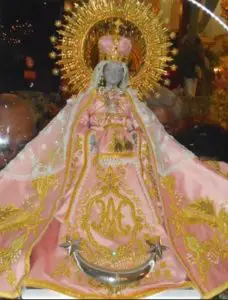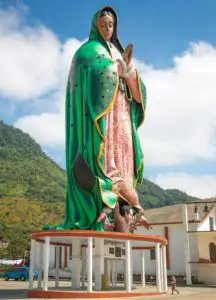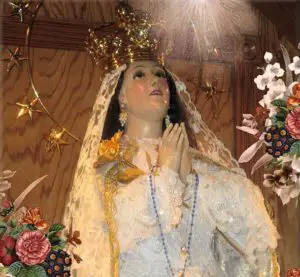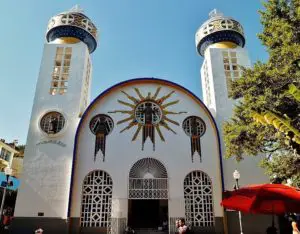Podcast: Play in new window | Download
Subscribe: Apple Podcasts | RSS
It would be an understatement to declare that religion is a vital part of the lives of most Mexicans. The modern country of Mexico is overwhelmingly Catholic, but some of its beliefs and rituals have foundations in its timeless indigenous past. As in other predominantly Catholic countries, the Virgin Mary, the earthly mother Jesus, plays an important role in the religious lives of Mexicans. Many different apparitions or aspects of the Virgin Mary in Mexico and many shrines devoted to her are known to many people outside the country. In fact, one of the largest religious pilgrimage sites in the entire world can be found in the heart of Mexico itself, in Mexico City, on a hill called Tepeyac. While many millions of visitors from dozens of countries make the pilgrimage to the shrine of the Virgin of Guadalupe every year, there are many smaller shrines and Marian devotions not well-known outside of Mexico or even outside their respective regions within Mexico. Here are four.
- La Virgen del Buen Suceso Santiago Tianguistenco
 La Virgen del Buen Suceso is often called in English, “Our Lady of Good Success,” or “Our Lady of Good Events.” The image of this Virgin and her veneration is traced back to two statues from the early days of the Spanish Empire, the mid-1500s. One statue was enshrined in Madrid while the other was taken to the town of Parañaque, just south of Manila in the Spanish Philippines. According to the official story of Our Lady of Good Success, the statue in Madrid was found by two Brothers from the Order of Saint Francis of Paola who found it in a cave while on a journey to Rome. The statue was cradling the Christ child in one arm and holding a scepter in the other. The Virgin was elaborately dressed and topped with a very intricate golden crown. The brothers carried the statue to Rome and told the Pope of their miraculous discovery. The pope made the Virgin the protectoress of the Order of Saint Francis of Paola, also known as the Brothers Minor in Service of the Sick. This is how the statue ended up in the Royal Hospital in Madrid, under the care of these brothers. The owners of the Atencio Hacienda in the Mexican state of México had a small chapel dedicated to La Virgen de Buen Suceso on their property. It was a local pilgrimage site and became particularly important in 1853 when the countryside was ravaged by a cholera epidemic. As a health-related Virgin, the locals believed in her power to heal and claimed many miracles and answered prayers related to the statue. The Atencio family loaned the Virgin out to the nearby town of San Pedro Tlaltizapan in 1866 when it experienced a very devastating smallpox epidemic which especially afflicted children. The statue was placed in the local church and within two days the smallpox epidemic ended. On the morning of the third day the caretakers of the church noticed that the Baby Jesus cradled in the arm of the Virgin was covered in spots. The faithful believed that the Baby Jesus had somehow absorbed or otherwise transferred the pox from the afflicted locals. During the 1860s there was great conflict between Church and State in Mexico and many church properties were confiscated by the government. Because this famous Virgin had a gold crown and thus had monetary value, La Virgen de Buen Suceso was hidden in the town of Santiago Tianguistenco and her devotion was held in secret. In 1912 and 1913, during the Mexican Revolution, the town was captured by forces loyal to Emiliano Zapata. The people of Santiago Tianguistenco prayed to the Virgin of Good Success for their liberation and when the Zapatista forces left, she was given credit for their departure. It wasn’t until 1919 that the statue itself resurfaced and public celebrations resumed with her official saint’s day fixed on January 1st. In 1947 Pope Pius the Twelfth granted the pontifical coronation to La Virgen del Buen Suceso Santiago Tianguistenco in recognition of her power to cure the sick and to intercede in times of trouble. The small shrine in this town receives thousands of visitors annually.
La Virgen del Buen Suceso is often called in English, “Our Lady of Good Success,” or “Our Lady of Good Events.” The image of this Virgin and her veneration is traced back to two statues from the early days of the Spanish Empire, the mid-1500s. One statue was enshrined in Madrid while the other was taken to the town of Parañaque, just south of Manila in the Spanish Philippines. According to the official story of Our Lady of Good Success, the statue in Madrid was found by two Brothers from the Order of Saint Francis of Paola who found it in a cave while on a journey to Rome. The statue was cradling the Christ child in one arm and holding a scepter in the other. The Virgin was elaborately dressed and topped with a very intricate golden crown. The brothers carried the statue to Rome and told the Pope of their miraculous discovery. The pope made the Virgin the protectoress of the Order of Saint Francis of Paola, also known as the Brothers Minor in Service of the Sick. This is how the statue ended up in the Royal Hospital in Madrid, under the care of these brothers. The owners of the Atencio Hacienda in the Mexican state of México had a small chapel dedicated to La Virgen de Buen Suceso on their property. It was a local pilgrimage site and became particularly important in 1853 when the countryside was ravaged by a cholera epidemic. As a health-related Virgin, the locals believed in her power to heal and claimed many miracles and answered prayers related to the statue. The Atencio family loaned the Virgin out to the nearby town of San Pedro Tlaltizapan in 1866 when it experienced a very devastating smallpox epidemic which especially afflicted children. The statue was placed in the local church and within two days the smallpox epidemic ended. On the morning of the third day the caretakers of the church noticed that the Baby Jesus cradled in the arm of the Virgin was covered in spots. The faithful believed that the Baby Jesus had somehow absorbed or otherwise transferred the pox from the afflicted locals. During the 1860s there was great conflict between Church and State in Mexico and many church properties were confiscated by the government. Because this famous Virgin had a gold crown and thus had monetary value, La Virgen de Buen Suceso was hidden in the town of Santiago Tianguistenco and her devotion was held in secret. In 1912 and 1913, during the Mexican Revolution, the town was captured by forces loyal to Emiliano Zapata. The people of Santiago Tianguistenco prayed to the Virgin of Good Success for their liberation and when the Zapatista forces left, she was given credit for their departure. It wasn’t until 1919 that the statue itself resurfaced and public celebrations resumed with her official saint’s day fixed on January 1st. In 1947 Pope Pius the Twelfth granted the pontifical coronation to La Virgen del Buen Suceso Santiago Tianguistenco in recognition of her power to cure the sick and to intercede in times of trouble. The small shrine in this town receives thousands of visitors annually.
- La Virgen Gigante de Xicotepec
In the northern sierra region of the state of Puebla a sleepy mountain town called Xicotepec de Juárez is home to one of Mexico’s newest Virgin Mary shrines. It is known in Mexico as “Monumental Virgen de Guadalupe,” or “The Monumental Virgin of Guadalupe.” For many years this town, whose unofficial motto is, “Wait 20 minutes and the weather will change,” wanted to do more to attract tourists. This gigantic, colorful statue of the iconic Virgin of Guadalupe measures some 75 feet tall and is made of hollowed-out cement. It stands looming over the city on  Tabacal Hill in the northern part of Xicotepec. This hill was important because it was here in 1949 that a silhouette of the Virgin of Guadalupe appeared in a broken half of a stone that was being quarried for a building project. Because of this usual occurrence, the locals decided to build a small chapel to the Virgin of Guadalupe on Tabacal Hill. The shrine received a steady trickle of visitors, especially on December 12th which is the feast day of the Virgin of Guadalupe. City officials wanted to expand the shrine and do something impactful that would draw even more tourists and pilgrims to Xicotepec. So, in the early 2000s a grassroots campaign began to raise money for a gigantic statue for Tabacal Hill. Construction on the “Virgen Monumental” began in October of 2006 and concluded on December 5, 2010. No machinery was used in the building of this statue and much of the work was done by volunteers from the town or surrounding area. As the statue is hollow, an inside staircase leads to a cramped observation deck inside the Virgin’s head with her eyes serving as windows. This was closed down within a few months as local religious leaders claimed that there was too much horseplay and goofing off happening inside the statue which was not appropriate for such a solemn monument. Since its completion in late 2010 the gigantic statue – some say the largest outside statue of the Virgin of Guadalupe in the world – has attracted tens of thousands of visitors. Two years after the statue’s dedication, Xicotepec was granted “Pueblo Mágico,” or “Magical Town” status by the Mexican government which put it on the map as a prime tourist destination. In 2018 the town constructed a gigantic cross on another part of Tabacal Hill and built a series of stairs connecting the cross with the Plaza de la Virgen de Guadalupe surrounding the statue. If the recent increase in visitors to Xicotepec is any indication, La Virgen Gigante de Xicotepec may turn into one of the most popular religious shrines in all of Mexico.
Tabacal Hill in the northern part of Xicotepec. This hill was important because it was here in 1949 that a silhouette of the Virgin of Guadalupe appeared in a broken half of a stone that was being quarried for a building project. Because of this usual occurrence, the locals decided to build a small chapel to the Virgin of Guadalupe on Tabacal Hill. The shrine received a steady trickle of visitors, especially on December 12th which is the feast day of the Virgin of Guadalupe. City officials wanted to expand the shrine and do something impactful that would draw even more tourists and pilgrims to Xicotepec. So, in the early 2000s a grassroots campaign began to raise money for a gigantic statue for Tabacal Hill. Construction on the “Virgen Monumental” began in October of 2006 and concluded on December 5, 2010. No machinery was used in the building of this statue and much of the work was done by volunteers from the town or surrounding area. As the statue is hollow, an inside staircase leads to a cramped observation deck inside the Virgin’s head with her eyes serving as windows. This was closed down within a few months as local religious leaders claimed that there was too much horseplay and goofing off happening inside the statue which was not appropriate for such a solemn monument. Since its completion in late 2010 the gigantic statue – some say the largest outside statue of the Virgin of Guadalupe in the world – has attracted tens of thousands of visitors. Two years after the statue’s dedication, Xicotepec was granted “Pueblo Mágico,” or “Magical Town” status by the Mexican government which put it on the map as a prime tourist destination. In 2018 the town constructed a gigantic cross on another part of Tabacal Hill and built a series of stairs connecting the cross with the Plaza de la Virgen de Guadalupe surrounding the statue. If the recent increase in visitors to Xicotepec is any indication, La Virgen Gigante de Xicotepec may turn into one of the most popular religious shrines in all of Mexico.
- Nuestra Señora de Tonatico
In the Mexican state of México halfway between the silver town of Taxco and the arts and crafts center of Metepec, a small town called Tonatico has an interesting religious history. When the Dominicans, Franciscans and Augustinians were busy converting the local Nahua people to Christianity, one of the townsfolk found a wooden female statue in the woods. History does not record if the sculpture was indigenous in origin or European, only that the face of this female carving was looking down. The person who discovered this statue took it to a local Catholic priest who  dressed it up in fancy silk clothes and proclaimed it to be the Virgin Mary, formally naming her Our Lady of Tonatico. In the late 1500s the religious authorities in the town built a special chapel to house the Virgin and many people from the countryside came to venerate her, claiming she was responsible for various miracles and intercessions. Sometime in the 1650s, the church at Tonatico burned to the ground with the statue of Nuestra Señora de Tonatico the only thing to survive the massive fire unscathed. Although untouched by the flames, worshippers were quick to notice that the face of the statue now looked up and had a smile instead of having a serious expression and looking down. This miraculous change in the image gave people hope for a better future and news of the transformation caused more people to come to Tonatico to pay their respects to the Virgin. By 1660 a new church was built, and this is the same place where the statue rests to this day. With its domed top, two steeples and ornate interior, the Sanctuary of Our Lady of Tonatico is an architectural jewel of the region. A special side room at the santuario is reserved for votive offerings and on any given day one can see a thousand or so devotional objects left by pilgrims. These may range from the personal, such as the shoes of a baby cured of an illness, to the elaborate, including everything from specially commissioned ex voto paintings to solid gold Milagro charms. For more information about Milagros and ex votos, please see Mexico Unexplained episode number one. https://mexicounexplained.com/the-magic-of-milagros/ The fiesta in honor of Our Lady of Tonatico is considered one of the most important religious festivals in the region. It begins each year on the last Sunday of January and ends on February 2, Candlemas Day. During this time, Tonatico receives pilgrims from all corners of the municipality, and from towns nearby in the states of Guerrero and Morelos. Those from the region who live abroad often make the trip back home during fiesta time, thanking the Virgin for a safe journey and for keeping them out of harm’s way in their new homelands.
dressed it up in fancy silk clothes and proclaimed it to be the Virgin Mary, formally naming her Our Lady of Tonatico. In the late 1500s the religious authorities in the town built a special chapel to house the Virgin and many people from the countryside came to venerate her, claiming she was responsible for various miracles and intercessions. Sometime in the 1650s, the church at Tonatico burned to the ground with the statue of Nuestra Señora de Tonatico the only thing to survive the massive fire unscathed. Although untouched by the flames, worshippers were quick to notice that the face of the statue now looked up and had a smile instead of having a serious expression and looking down. This miraculous change in the image gave people hope for a better future and news of the transformation caused more people to come to Tonatico to pay their respects to the Virgin. By 1660 a new church was built, and this is the same place where the statue rests to this day. With its domed top, two steeples and ornate interior, the Sanctuary of Our Lady of Tonatico is an architectural jewel of the region. A special side room at the santuario is reserved for votive offerings and on any given day one can see a thousand or so devotional objects left by pilgrims. These may range from the personal, such as the shoes of a baby cured of an illness, to the elaborate, including everything from specially commissioned ex voto paintings to solid gold Milagro charms. For more information about Milagros and ex votos, please see Mexico Unexplained episode number one. https://mexicounexplained.com/the-magic-of-milagros/ The fiesta in honor of Our Lady of Tonatico is considered one of the most important religious festivals in the region. It begins each year on the last Sunday of January and ends on February 2, Candlemas Day. During this time, Tonatico receives pilgrims from all corners of the municipality, and from towns nearby in the states of Guerrero and Morelos. Those from the region who live abroad often make the trip back home during fiesta time, thanking the Virgin for a safe journey and for keeping them out of harm’s way in their new homelands.
- Nuestra Señora de La Soledad de Acapulco
 Located in the central square of Acapulco, Mexico’s oldest Pacific port, is the rather out-of-place Acapulco Cathedral consecrated to Our Lady of Solitude. The building looks more like a mosque with its domed towers and other architectural elements combining Moorish and Byzantine styles. This place of worship did not always look this way. On the spot of this blue, white and gold building, one of the oldest churches on the Pacific coast was built in the early 1530s to serve the growing port which would develop into a main stop in Spain’s galleon trade with the Far East. In 1556, newly crowned King Phillip the Second of Spain gave the city of Acapulco an important gift: a beautiful carving of the Virgin Mary as Our Lady of Solitude. The king of Spain would have the statue made into a general of the Spanish Army as a symbolic gesture of earthly protection to guard Spanish interests in the Pacific. The beautiful statue drew many pilgrims and those engaged in trans-Pacific trade with the Orient would visit her to ensure a successful and profitable voyage. In her role as protectoress of Acapulco, the Virgin has proved unconquerable. Over the many centuries of her residency in this beautiful port city she has born witness to violent tropical storms, fires, floods, pirate attacks and various degrees of civil unrest. Additionally, she has been housed in ever-changing structures which have seen many renovations, partial demolitions and outright destruction. In 1909 an earthquake collapsed the roof of the cathedral. It was rebuilt, only to be destroyed again by a cyclone in 1938. Throughout all these calamities, the statue of the Virgin of Solitude survived unharmed which seemed only to intensify the faith of the true believers who saw her as a very generous giver of miracles. To this day, locals pray to her and visit her to ask for help in impossible situations. Hundreds of thousands of people across time can testify to her enduring power.
Located in the central square of Acapulco, Mexico’s oldest Pacific port, is the rather out-of-place Acapulco Cathedral consecrated to Our Lady of Solitude. The building looks more like a mosque with its domed towers and other architectural elements combining Moorish and Byzantine styles. This place of worship did not always look this way. On the spot of this blue, white and gold building, one of the oldest churches on the Pacific coast was built in the early 1530s to serve the growing port which would develop into a main stop in Spain’s galleon trade with the Far East. In 1556, newly crowned King Phillip the Second of Spain gave the city of Acapulco an important gift: a beautiful carving of the Virgin Mary as Our Lady of Solitude. The king of Spain would have the statue made into a general of the Spanish Army as a symbolic gesture of earthly protection to guard Spanish interests in the Pacific. The beautiful statue drew many pilgrims and those engaged in trans-Pacific trade with the Orient would visit her to ensure a successful and profitable voyage. In her role as protectoress of Acapulco, the Virgin has proved unconquerable. Over the many centuries of her residency in this beautiful port city she has born witness to violent tropical storms, fires, floods, pirate attacks and various degrees of civil unrest. Additionally, she has been housed in ever-changing structures which have seen many renovations, partial demolitions and outright destruction. In 1909 an earthquake collapsed the roof of the cathedral. It was rebuilt, only to be destroyed again by a cyclone in 1938. Throughout all these calamities, the statue of the Virgin of Solitude survived unharmed which seemed only to intensify the faith of the true believers who saw her as a very generous giver of miracles. To this day, locals pray to her and visit her to ask for help in impossible situations. Hundreds of thousands of people across time can testify to her enduring power.
REFERENCES
Many thanks to the Pregunta Santoral web site (in Spanish): https://www.preguntasantoral.es/
